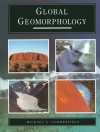We live in the Quaternary Ice Age, the last million years when large ice sheets covered much of North America and Eurasia, with successive glaciations lasting about 90, 000 years interspersed with interglaciations lasting about 10, 000 years, such as our preset Holocene interglaciation. Quaternary glaciations were discovered and mapped by glacial geologists from evidence for glacial erosion and deposition on a large scale. Glaciology began as a descriptive branch of geology and has become a quantitative branch of physics. Glaciology and glacial geology are two sides of the same coin. Glaciologists study ice dynamics to model present and past ice sheets. Glacial geologists study the evidence produced by ice dynamics, evidence that controls the models. This book is written for glacial geologists that have a modest exposure to mathematics so they can understand the fundamental link between glaciology and glacial geology. This link is the height of an ice sheet above its bed. Ice height depends primarily on the strength of ice-bed coupling. The stronger the coupling, the higher the ice, and therefore the larger the ice sheet. Glacial geology allows an assessment of ice-bed coupling. Coupling weakens under the interior of an ice sheet when a frozen bed thaws and thereby allows ice to slide over the bed to produce glacial geology by erosion and deposition processes. Coupling weakens much more near ice-sheet margins where ice moves as fast currents called ice streams, under which ice-bed coupling vanishes where basal water drowns bedrock bumps or soaks basal sediments.The book consists of seven chapters. Chapter One shows how glacial geology can be used to quantify the strength of ice-bed coupling. Chapter Two quantifies how coupling is weakened when a frozen bed thaws for slow sheet flow in the interior of an ice sheet, thereby lowering the ice surface. Chapter Three quantifies how the surface is lowered much more toward the margin of an ice sheet where basal water partly downs the bed along linear topography (river valleys, coastal straits, etc.), allowing for slow sheet flow to become fast stream flow. Chapter Four quantifies the ability of large partly confined floating ice shelves to reduce the discharge from fast ice streams entering the sea. Chapter Five discusses glacial geology produced by Northern Hemisphere ice sheets during a cycle of Quaternary glaciation, with a white hole needed to initiate an ice sheet, marine ice transgression needed to grow it, and marine ice instability needed to terminate it; these are all linked to glacial geology. Chapter Six shows how the Arctic ice sheet can be reconstructed during a cycle of Quaternary glaciation using glacial geology. Chapter Seven shows how glacial geology can be mapped under the Antarctic ice sheet as it exists today, with an emphasis on ongoing gravitational collapse of the Western Antarctic Ice Sheet, grounded mostly below sea level in the Western Hemisphere.
Terence J Hughes
Glaciology for Glacial Geologists [PDF ebook]
Glaciology for Glacial Geologists [PDF ebook]
Dieses Ebook kaufen – und ein weitere GRATIS erhalten!
Format PDF ● Seiten 276 ● ISBN 9781536127942 ● Herausgeber Terence J Hughes ● Verlag Nova Science Publishers ● Erscheinungsjahr 2018 ● herunterladbar 3 mal ● Währung EUR ● ID 7217476 ● Kopierschutz Adobe DRM
erfordert DRM-fähige Lesetechnologie












